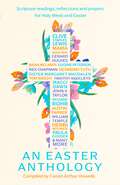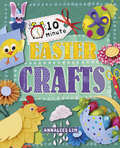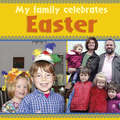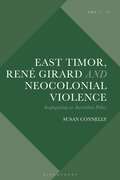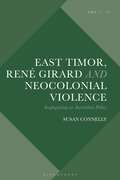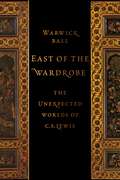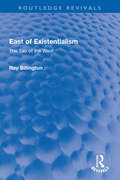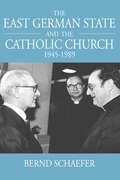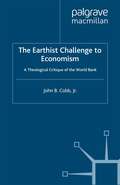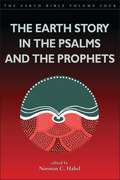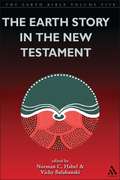- Table View
- List View
An Easter Anthology: Scripture readings, reflections and prayers for Holy Week and Easter
by Arthur HowellsA beautiful gift anthology for the season of Easter with material from Tom Wright, Timothy Radcliffe, Basil Hume, Rowan Williams, Brian McLaren, Paula Gooder, Henri Nouwen, Desmond Tutu, Maria Boulding. Compiled by Canon Arthur Howells, a retired canon in the Church in Wales, this delightful collection is the perfect gift for the Lenten season.
Easter
by Michael ArdittiWinner of the Mardi Gras and Waterstone's Book awards, longlisted for the Costa Novel award'It's a delight to find a modern novel that takes religion and all the objections to it seriously as a subject: the rockpool of a London parish teems with all kinds of curious life' Philip Pullman'Michael Arditti writes about Western Christianity, as it is manifest in the present Church of England, with pungency and satirical frankness. His style has Joycean echoes' Muriel SparkA Vicar and his congregation are caught up in a latter-day Passion story that will tear apart their lives.The parish of St Mary-in-the-Vale is preparing for Easter. In his Palm Sunday sermon, the Vicar explains that Christ's crucifixion and redemption are taking place every day. He little suspects that, before the week's out, he and his entire congregation will be caught up in a latter-day Passion story which will tear apart their lives. Michael Arditti's magnificent novel is both a devastating portrait of today's Church of England and an audacious reworking of the central myth of Western culture. Taking the form of a traditional triptych, it is at once intimate and epic, lyrical and analytic. Shocking events unfold against a backdrop of meticulously observed religious services. High Church ritual, evangelical revivalism and the ancestor-worship of the English gentry are all subjected to merciless scrutiny.
Easter: Easter (library Ebook) (10 Minute Crafts #6)
by Annalees LimUsing readily available, seasonally related materials, this series is packed full of fun crafts for special occasions. The projects are explained in easy-to-follow, step-by-step instructions, and are perfect for teachers looking for original ideas as well as time-poor parents. In 10 Minute Crafts: Easter, children can learn how to make an Easter bonnet, fluffy Easter chicks, a sparkling shower hanging and cute bunny egg cups for their Easter eggs, along with lots of other great Easter crafts for kids.
Easter: Easter My Family Celebrates: Easter (PDF) (My Family Celebrates)
by Cath SenkerThis book introduces the reader to the festival of Easter and explores how one child and his family celebrate it. The book includes panels to show how people around the world celebrate Easter and a Easter recipe for you to try yourself.
Easter: An Introductory Reader (Pocket Library Of Spiritual Wisdom Ser.)
by Rudolf SteinerRudolf Steiner, the often undervalued, multifaceted genius of modern times, contributed much to the regeneration of culture. In addition to his philosophical teachings, he provided ideas for the development of many practical activities, including education - both general and special - agriculture, medicine, economics, architecture, science, religion and the arts.Steiner's original contribution to human knowledge was based on his ability to conduct 'spiritual research', the investigation of metaphysical dimensions of existence. With his scientific and philosophical training, he brought a new systematic discipline to the field, allowing for conscious methods and comprehensive results. A natural seer from childhood, he cultivated his spiritual vision to a high degree, enabling him to speak with authority on previously veiled mysteries of life.Samples of Steiner's work are to be found in this introductory reader in which Matthew Barton brings together excerpts from Steiner's many talks and writings on Easter. The volume also features an editorial introduction, afterword, commentary and notes. Chapters: Can we Celebrate Easter?; The Earth and the Cosmos; Rising Sun: Nature and Resurrection; Golgotha, the Central Deed of Evolution; Easter, a Festival for the Future.
East Timor, René Girard and Neocolonial Violence: Scapegoating as Australian Policy (Violence, Desire, and the Sacred)
by Susan ConnellyIn a new historical interpretation of the relationship between Australia and East Timor, Susan Connelly draws on the mimetic theory of René Girard to show how the East Timorese people were scapegoated by Australian foreign policy during the 20th century.Charting key developments in East Timor's history and applying three aspects of Girard's framework – the scapegoat, texts of persecution and conversion – Connelly reveals Australia's mimetic dependence on Indonesia and other nations for security. She argues that Australia's complicity in the Indonesian invasion and occupation of East Timor perpetuated the sacrifice of the Timorese people as victims, thus calling into question the traditional Australian values of egalitarianism and fairness. Connelly also examines the embryonic conversion process apparent in levels of recognition of the innocent victim and of the Australian role in East Timor's suffering, as well as the consequent effects on Australian self-perception.Emphasising Girardian considerations of fear, suffering, forgiveness and conversion, this book offers a fresh perspective on Australian and Timorese relations that in turn sheds light on the origins and operations of human violence.
East Timor, René Girard and Neocolonial Violence: Scapegoating as Australian Policy (Violence, Desire, and the Sacred)
by Susan ConnellyIn a new historical interpretation of the relationship between Australia and East Timor, Susan Connelly draws on the mimetic theory of René Girard to show how the East Timorese people were scapegoated by Australian foreign policy during the 20th century.Charting key developments in East Timor's history and applying three aspects of Girard's framework – the scapegoat, texts of persecution and conversion – Connelly reveals Australia's mimetic dependence on Indonesia and other nations for security. She argues that Australia's complicity in the Indonesian invasion and occupation of East Timor perpetuated the sacrifice of the Timorese people as victims, thus calling into question the traditional Australian values of egalitarianism and fairness. Connelly also examines the embryonic conversion process apparent in levels of recognition of the innocent victim and of the Australian role in East Timor's suffering, as well as the consequent effects on Australian self-perception.Emphasising Girardian considerations of fear, suffering, forgiveness and conversion, this book offers a fresh perspective on Australian and Timorese relations that in turn sheds light on the origins and operations of human violence.
East of the Wardrobe: The Unexpected Worlds of C. S. Lewis
by Warwick BallA fascinating look at the rich but under-appreciated Eastern sources behind the Narnia book C. S. Lewis was no great traveller but he was a prodigious bibliophile who absorbed the world's traditions of myth, religion, and cosmology. The Chronicles of Narnia are steeped in allusions to the Bible, Greek mythology, and medieval literature, all of which has been amply discussed by critics. But, until now, what has been overlooked are Lewis' significant borrowings from Eastern influences: Arabian Nights and the Persian poets, great travellers from Herodotus and Marco Polo to T. E. Lawrence and Robert Byron, and the famous fictional adventurers Baron Munchausen, Gulliver, and Sindbad. In East of the Wardrobe, Warwick Ball explores hitherto unrecognised and unexpected Eastern aspects in and influences on C. S. Lewis' Narnia books. These include storylines, themes, imagery, religious elements, and even the cities and landscapes of the East, as well as the 'Persian' style adopted by the illustrator of Narnia, Pauline Baynes. Themes borrowed from the great epics can also be found, from The Odyssey and Aeneid to the Kalevala and The Knight in the Panther's Skin. Delve deeper and Christianity is there along with paganism, but so too are Zoroastrian, Manichaean, and even Islamic and Sufi messages. Ultimately, these influences act as a reflection of the complex intellectual world that Lewis inhabited, of both his own unique philosophy and the wider social and intellectual climate of Oxford in the first half of the twentieth century. All readers of Lewis will find in East of the Wardrobe surprising new paths into the world of Narnia.
East of the Wardrobe: The Unexpected Worlds of C. S. Lewis
by Warwick BallA fascinating look at the rich but under-appreciated Eastern sources behind the Narnia book C. S. Lewis was no great traveller but he was a prodigious bibliophile who absorbed the world's traditions of myth, religion, and cosmology. The Chronicles of Narnia are steeped in allusions to the Bible, Greek mythology, and medieval literature, all of which has been amply discussed by critics. But, until now, what has been overlooked are Lewis' significant borrowings from Eastern influences: Arabian Nights and the Persian poets, great travellers from Herodotus and Marco Polo to T. E. Lawrence and Robert Byron, and the famous fictional adventurers Baron Munchausen, Gulliver, and Sindbad. In East of the Wardrobe, Warwick Ball explores hitherto unrecognised and unexpected Eastern aspects in and influences on C. S. Lewis' Narnia books. These include storylines, themes, imagery, religious elements, and even the cities and landscapes of the East, as well as the 'Persian' style adopted by the illustrator of Narnia, Pauline Baynes. Themes borrowed from the great epics can also be found, from The Odyssey and Aeneid to the Kalevala and The Knight in the Panther's Skin. Delve deeper and Christianity is there along with paganism, but so too are Zoroastrian, Manichaean, and even Islamic and Sufi messages. Ultimately, these influences act as a reflection of the complex intellectual world that Lewis inhabited, of both his own unique philosophy and the wider social and intellectual climate of Oxford in the first half of the twentieth century. All readers of Lewis will find in East of the Wardrobe surprising new paths into the world of Narnia.
East of Existentialism: The Tao of the West (Routledge Revivals)
by Ray BillingtonFirst published in 1990, East of Existentialism was written to explore new perspectives on eternal questions such as ‘Who am I?’, ‘Why am I here?’, and ‘Where am I going?’. The book brings together insights from existentialism in the West and Hinduism, Buddhism, and Taoism in the East, and presents practical case studies throughout to show the student how apparently abstruse themes relate to real-life situations. Divided into three parts, the first considers major Western contributions to the themes of human nature and destiny. The central section examines the connection between existentialism in the West and dominant philosophical schools in India and China. The last three chapters explore the relevance of Eastern ideas to Western thought, not only to provide philosophical theory but also to offer a greater understanding of moral and social dilemmas and of practical living. A full glossary explains the technical terms used in the book. East of Existentialism will appeal to those with an interest in philosophy and religious studies.
East of Existentialism: The Tao of the West (Routledge Revivals)
by Ray BillingtonFirst published in 1990, East of Existentialism was written to explore new perspectives on eternal questions such as ‘Who am I?’, ‘Why am I here?’, and ‘Where am I going?’. The book brings together insights from existentialism in the West and Hinduism, Buddhism, and Taoism in the East, and presents practical case studies throughout to show the student how apparently abstruse themes relate to real-life situations. Divided into three parts, the first considers major Western contributions to the themes of human nature and destiny. The central section examines the connection between existentialism in the West and dominant philosophical schools in India and China. The last three chapters explore the relevance of Eastern ideas to Western thought, not only to provide philosophical theory but also to offer a greater understanding of moral and social dilemmas and of practical living. A full glossary explains the technical terms used in the book. East of Existentialism will appeal to those with an interest in philosophy and religious studies.
The East German State and the Catholic Church, 1945-1989 (Studies in German History #11)
by Bernd SchaeferFrom 1945 to 1989, relations between the communist East German state and the Catholic Church were contentious and sometimes turbulent. Drawing on extensive Stasi materials and other government and party archives, this study provides the first systematic overview of this complex relationship and offers many new insights into the continuities, changes, and entanglements of policies and strategies on both sides. Previously undiscovered records in church archives contribute to an analysis of regional and sectoral conflicts within the Church and various shades of cooperation between nominal antagonists. The volume also explores relations between the GDR and the Vatican and addresses the oft-neglected communist “church business” controversially made in exchange for hard Western currency.
East German Dissidents and the Revolution of 1989: Social Movement in a Leninist Regime
by C. JoppkeIn contrast to the dissident movements of Eastern Europe, the East German movement remained committed to the 'revisionist' reform of the communist regime. This book tries to explain why. It is argued that the peculiarities of German history and culture prevented the possibility of a 'national' opposition to communism. As a result, East German dissidents had to remain in a paradoxical way 'loyal' to the old regime.
The East German Church and the End of Communism
by John P. BurgessThis book addresses the role of religion in the massive political changes that took place in Eastern Europe in 1989. In particular, it examines the role played by the East German church in that country's bloodless revolution. Although some scholars and political commentators have noted that the East German church provided a free space in which dissident groups could meet, they have neither described nor assessed the theology that guided the church's political involvement. Drawing on his own research in East Germany and relying primarily on sources published in East Germany itself, John Burgess demonstrates the roots of the church's theology in Barth, Bonhoeffer, and in the Barmen declaration, which in 1934 pronounced Christianity and Nazi ideology to be incompatible. He explores how the dissident groups drew on church symbols and language to develop a popular alternative theology, and finally shows how the theological tension between the church and the dissidents provided impulses for political democratization.
The East Asian Region: Confucian Heritage and Its Modern Adaptation
by Gilbert RozmanThe contributors to this volume range over 2,000 years of history as they show how Confucian values spread throughout the region in premodern times and how these values were transformed in an age of modernization. The introduction by Gilbert Rozman discusses the special character of East Asia. In Part I Patricia Ebrey analyzes the Confucianization of China; JaHyun Kim Haboush, that of Korea; and Martin Collcutt, the much later diffusion of Confucianism in Japan. In Part II Rozman compares types of Confucianism in nineteenth-century China and Japan and their adaptability in the twentieth century, while Michael Robinson adds an overview of modern Korean perceptions of Confucianism.Originally published in 1990.The Princeton Legacy Library uses the latest print-on-demand technology to again make available previously out-of-print books from the distinguished backlist of Princeton University Press. These editions preserve the original texts of these important books while presenting them in durable paperback and hardcover editions. The goal of the Princeton Legacy Library is to vastly increase access to the rich scholarly heritage found in the thousands of books published by Princeton University Press since its founding in 1905.
The East African Revival: History and Legacies
by Kevin WardFrom the 1930s the East African Revival influenced Christian expression in East Central Africa and around the globe. This book analyses influences upon the movement and changes wrought by it in Uganda, Rwanda, Burundi, Kenya, Tanzania and Congo, highlighting its impact on spirituality, political discourse and culture. A variety of scholarly approaches to a complex and changing phenomenon are juxtaposed with the narration of personal stories of testimony, vital to spirituality and expression of the revival, which give a sense of the dynamism of the movement. Those yet unacquainted with the revival will find a helpful introduction to its history. Those more familiar with the movement will discover new perspectives on its influence.
The East African Revival: History and Legacies
by Kevin WardFrom the 1930s the East African Revival influenced Christian expression in East Central Africa and around the globe. This book analyses influences upon the movement and changes wrought by it in Uganda, Rwanda, Burundi, Kenya, Tanzania and Congo, highlighting its impact on spirituality, political discourse and culture. A variety of scholarly approaches to a complex and changing phenomenon are juxtaposed with the narration of personal stories of testimony, vital to spirituality and expression of the revival, which give a sense of the dynamism of the movement. Those yet unacquainted with the revival will find a helpful introduction to its history. Those more familiar with the movement will discover new perspectives on its influence.
The Earthy Nature of the Bible: Fleshly Readings of Sex, Masculinity, and Carnality
by R. BoerThrough a series of close readings, Boer explores the earthy nature of the Bible. These readings are gathered into three parts: the Song of Songs; Masculinities; Paraphilias. Each study is undertaken with rigorous attention to relevant scholarship and significant theoretical engagement (especially with psychoanalysis, ecocriticism and Marxism).
Earthquakes and Gardens: Saint Hilarion’s Cyprus (Class 200: New Studies in Religion)
by Virginia BurrusEssays about ruination, resilience, reading, and religion generated by a reflection on a fourth-century hagiography. In Jerome’s Life of Saint Hilarion, a fourth-century saint briefly encounters the ruins of an earthquake-toppled city and a haunted garden in Cyprus. From these two fragmentary passages, Virginia Burrus delivers a series of sweeping meditations on our experience of place and the more-than-human worlds—the earth and its gods—that surround us. Moving between the personal and geological, Earthquakes and Gardens ruminates on destruction and resilience, ruination and resurgence, grief and consolation in times of disaster and loss. Ultimately, Burrus’s close readings reimagine religion as a practice that unsettles certainty and develops mutual flourishing.
Earthquakes and Gardens: Saint Hilarion’s Cyprus (Class 200: New Studies in Religion)
by Virginia BurrusEssays about ruination, resilience, reading, and religion generated by a reflection on a fourth-century hagiography. In Jerome’s Life of Saint Hilarion, a fourth-century saint briefly encounters the ruins of an earthquake-toppled city and a haunted garden in Cyprus. From these two fragmentary passages, Virginia Burrus delivers a series of sweeping meditations on our experience of place and the more-than-human worlds—the earth and its gods—that surround us. Moving between the personal and geological, Earthquakes and Gardens ruminates on destruction and resilience, ruination and resurgence, grief and consolation in times of disaster and loss. Ultimately, Burrus’s close readings reimagine religion as a practice that unsettles certainty and develops mutual flourishing.
Earthly Vows
by Patricia HickmanThe award-winning author of Fallen Angels, Nazareth's Song, and Whisper Town delivers the final novel in the acclaimed Millwood Hollow Series of role reversals, strange bedfellows, and ultimate redemption. Jeb Nubey and Fern Coulter are finally setting a wedding date, but their plans are derailed when a trip to Oklahoma to visit Fern's family catapults them into Fern's past 'the past she would prefer remained buried. Additionally, the challenges and perks that come with the wealthy community church Jeb is called to lead give him food for growth; however, this new found enlightenment appears arrogant in light of Fern's insecurities. In the midst of their struggles, Jeb and Fern must also deal with the disappearance of Angele 'Jeb' s adopted daughter. He must retrieve her from the dangerous young man who has played on her vulnerabilities and lured her away promising to fill the emptiness she feels. Earthly Vows takes a look at how easily those we think we know so well can fall into behaviors and make decisions we would never expect. Through this, Hickman shows how broken circles can be redeemed and how we can find beauty in life's flaws.
The Earthist Challenge to Economism: A Theological Critique of the World Bank
by J. CobbWestern society moved from a period in which Christianity was the dominant spiritual force to one of nationalism and then to making the economy the object of public devotion. Today this is challenged by those seeking the health of the Earth including all its inhabitants. The World Bank is the economistic institution most open to Earthist concerns. The book evaluates the Bank's potential for leadership in broadening public goals from narrowly economic goods to inclusive ones.
Earth Story in Wisdom Traditions
by Norman C. Habel Shirley WurstIn this volume scholars from around the world read the story of the Earth in major Wisdom Traditions using the ecojustice principles outlined in Volume 1, 'Readings from the Perspective of Earth'. These readings uncover a range of fresh perspectives about Earth in seeking to discover where the voices of Earth are suppressed or heard in the Wisdom texts. Some texts reveal an ecokinship between Earth and Wisdom. Texts from Job challenge a cosmic model that gives priority to heaven over Earth. Still others challenge the mandate to dominate in Genesis 1.28. In many texts, Wisdom provides a vehicle for a new kinship with Earth. Comtributors include Jenny Wightman, Hendrik Viviers, Carole Fontaine, Izak Spangenberg, Alice Sinnott, Willie van Heerden, Katherine Dell, Dale Patrick, Marie Turner and Laura Hobgood-Oster.
Earth Story in the Psalms and the Prophets
by Norman C. HabelIn this volume, scholars from around the world read the story of Earth in key texts from the Psalms and the Prophets.Their readings challenge popular understandings of the Chaoskampf myth, the theophany of Psalm 29 and the New Earth in Isaiah 65. Re-readings of Ezekiel expose the cruelty of divine justice extended to the natural world. Several articles by indigenous writers sensitive to the voice of Earth bring new insights to the potential meaning of texts like Psalm 104. Contributors include Lloyd Geering, Russell Nelson, William Urbrock, Laurie Braaten, Keith Carley, Anne Gardner, John Olley, Gunther Wittenberg, Kalinda Stevenson, Peter Trudinger, Arthur Walker-Jones, Norman Charles, Howard Wallace, Geraldine Avent, Madipoane Masenya and Abotchie Ntreh.
The Earth Story in the New Testament: Volume 5
by Vicky Balabanski Norman C. HabelThe "Earth Bible" is an international project, including volumes on ecojustice readings of major sections of the Bible. The basic aims of the Earth Bible project are: to develop ecojustice principles appropriate to an Earth hermeneutic for interpreting the Bible and for promoting justice and healing for Earth; to publish these interpretations as contributions to the current debate on ecology, ecoethics and ecotheology; to provide a responsible forum within which the suppressed voice of Earth may be heard and impulses for healing Earth may be generated. The project explores text and tradition from the perspective of Earth, employing a set of ecojustice principles developed in consultation with ecologists, suspecting that the text and/or its interpreters may be anthropocentric and not geocentric, but searching to retrieve alternative traditions that hear the voice of Earth and value Earth as more than a human instrument. The lead article in Volume V is a reflection in responses to the ecojustice principles employed in the hermeneutic of the project. Several articles offer insights into New Testament texts that seem to devalue Earth in favour of heaven. The final article by Barbara Rossing challenges the popular apocalyptic notion that in the new age Earth will be terminated. A feature of this volume is a dialogue between Norman Habel, who argues that John One seems to devalue Earth, and two respondents, Elaine Wainwright and Vicky Balabanski (who is coeditor of this volume with Norman Habel). 1
